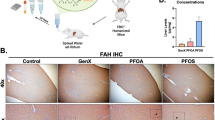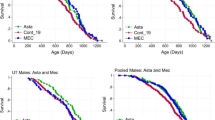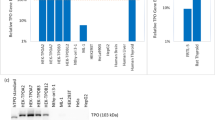Abstract
It is known that the carcinogenic effect of estragole, a component of essential oils of many spicy plants, is characterized by species, tissue, and sex specificity. It causes mainly liver tumors in female mice but is not carcinogenic for male mice and for rats. In this work, the estragole hepatocarcinogenicity was shown for female mice of previously not studied ICR line. The strict correlation between estragole hepatocarcinogenicity and its ability to decrease the level of glucocorticoid induction of liver-specific enzymes tyrosine aminotransferase (TAT) and tryptophan oxygenase (TO) was found. Inhibition of TAT and TO inducibility by estragole takes place only in female mice but not in male mice and in rats. Studying the estragole effect on DNA-binding activity of transcription factors, present mainly in liver and regulating expression of genes encoding liver-specific proteins, has shown that estragole decreases FOXA and HNF4 activities but not activities of C/EBP and HNF1, and this happens only in female mice, for which this substance is hepatocarcinogen, but not in male mice and in rats. Pentachlorophenol, preventing hepatocarcinogenic effect of estragole, abolishes inhibitory influence of the latter on the TAT and TO glucocorticoid induction and restores DNA-binding activity of FOXA and HNF4. Thus, a correlation was revealed between the estragole hepatocarcinogenic effect and decrease in DNA-binding activity of transcription factors FOXA and HNF4, which might be indicative of the role of these factors in tumor suppression mechanisms in liver.
Similar content being viewed by others
Abbreviations
- C/EBP:
-
CCAAT/enhancer binding protein
- DENA:
-
diethylnitrosamine
- FOXA:
-
family of A proteins containing fox domain (forkheadbox A)
- HNF1, -4:
-
hepatocyte nuclear factors 1 and 4
- i.p.:
-
intraperitoneal
- 3′-MeDAB:
-
3′-methyl-4-dimethylaminobenzene
- OAT:
-
ortho-aminoazotoluene
- TAT:
-
L-tyrosine:2-oxoglutarate aminotransferase
- TO:
-
L-tryptophan:oxygen2,3-oxidoreductase
References
Anderson, R. A., Raina, P. N., and Milholland, R. J. (1966) Oncologia, 20, 153–166.
Fiala, S., and Fiala, A. E. (1959) Brit. J. Cancer, 13, 236–250.
Kensler, T. W., Busby, W. F., Davidson, N. E., and Wogan, G. N. (1976) Cancer Res., 36, 4647–4651.
Horikoshi, N., Tashiro, F., Tanaka, N., and Ueno, Y. (1988) Cancer Res., 48, 5188–5192.
Kaledin, V. I., and Zakharova, N. P. (1984) in Investigations. on Malignant Tumor Induction and Metastasis in Experimental Animals (Gruntenko, E. V., ed.) [in Russian], Novosibirsk, pp. 146–185.
Merkulova, T. I., Kropachev, K. Y., Timofeeva, O. A., Vasiliev, G. V., Levashova, Z. B., Ilnitskaya, S. I., Kobzev, V. F., Pakharukova, M. Y., Bryzgalov, L. O., and Kaledin, V. I. (2005) Mol. Carcinog., 44, 223–232.
Merkulova, T. I., Kaledin, V. I., Kropachev, K. Y., Kobzev, V. F., and Vasiliev, G. V. (1998) Doklady RAN, 361, 700–703.
Kropachev, K. Y., Kaledin, V. I., Kobzev, V. F., Plisov, S. Y., and Merkulova, T. I. (2001) Mol. Carcinog., 31, 10–15.
Roux, J., Pictet, P., and Grange, T. (1995) DNA Cell Biol., 14, 17–20.
Schrem, H., Klempnauer, J., and Borlak, J. (2002) Pharmacol. Rev., 54, 129–158.
Nakamura, T., Mura, T., Saito, K., Ohsawa, T., Akiyoshi, H., and Sato, K. (1998) Biochem. Biophys. Res. Commun., 253, 352–357.
Miller, E. C., Swanson, A. B., Phillips, D. H., Fletcher, T. L., Liem, A., and Miller, J. A. (1983) Cancer Res., 43, 1124–1134.
Cereghini, S., Raymondjen, M., Carranca, A., Herbomel, P., and Yaniv, M. (1987) Cell, 50, 627–638.
Lai, E., Prezioso, V., Smith, E., Litvin, O., Costa, R., and Darnell, J. (1990) Genes Dev., 4, 1427–1436.
Espinas, M., Roux, J., Ghysdael, J., Pictet, R., and Grange, T. (1994) Mol. Cell Biol., 14, 4116–4125.
Nitch, D., Boshart, M., and Schutz, G. (1993) Proc. Natl. Acad. Sci. USA, 90, 5479–5483.
Diehl, A. M., and Yang, S. Q. (1994) Hepatology, 19, 447–456.
Kaledin, V. I., Klimova, N. V., Vasiliev, G. V., Ivanova, E. A., Vasilieva, E. D., and Ilnitskaya, S. I. (2003) Byul. Eksp. Biol. Med., 136, 435–437.
Merkulova, T. I., Kropachev, K. Y., Timofeeva, O. A., Vasiliev, G. V., Ilnitskaya, S. I., Levashova, Z. B., Kobzev, V. F., and Kaledin, V. I. (2003) Biochemistry (Moscow), 68, 520–528.
Kaledin, V. I., Vasyunina, E. A., Ovchinnikova, L. P., Ronichevskaya, G. M., Zvereva, L. N., and Ilnitskaya, S. I. (2002) Vestnik VOGIS, 21/22, 11–19.
Kaledin, V. I., Glazko, T. T., and Zakharova, N. N. (1979) Doklady RAN, 244, 233–237.
Boberg, E. W., Miller, E. C., Miller, J. A., Poland, A., and Liem, A. (1983) Cancer Res., 43, 5163–5173.
Bock, K. W., and Schirmer, G. (1987) Arch. Toxicol. Suppl., 10, 125–135.
Kaltschmidt, C., Muller, M., Brem, G., and Renkawitz, R. (1994) Mech. Dev., 45, 203–210.
Schoneveld, O. J., Gaemers, I. C., and Lamers, W. H. (2004) Biochim. Biophys. Acta, 1680, 114–128.
Kropachev, K. Y., Pakharukova, M. Yu., Bryzgalov, L. O., Kaledin, V. I., Kobzev, V. F., and Merkulova, T. I. (2004) Doklady RAN, 397, 694–696.
Drinkwater, N. R., Miller, E. C., Miller, J. A., and Pitot, H. C. (1976) J. Nat. Cancer Inst., 57, 1323–1331.
Granner, D. K., and Hargrove, J. L. (1983) Mol. Cell. Biochem., 53/54, 113–128.
Schmid, W., Scherer, G., Dabtsch, H., Patric, M., and Schutz, G. (1982) EMBO J., 1, 1287–1293.
Pakharukova, M. Yu., Smetanina, M. A., Kaledin, V. I., Kobzev, V. F., Romanova, I. V., and Merkulova, T. I. (2007) Byul. Eksp. Biol. Med., 144, 313–316.
Grange, T., Roux, J., Rigaud, G., and Pictet, R. (1991) Nucleic Acids Res., 19, 131–139.
Schrem, H., Klempnauer, J., and Borlak, J. (2004) Pharmacol. Rev., 56, 291–330.
Abelev, G. I., and Lazarevich, N. L. (2006) Adv. Cancer Res., 95, 61–113.
Author information
Authors and Affiliations
Corresponding author
Additional information
Original Russian Text © V. I. Kaledin, M. Yu. Pakharukova, E. N. Pivovarova, K. Yu. Kropachev, N. V. Baginskaya, E. D. Vasilieva, S. I. Ilnitskaya, E. V. Nikitenko, V. F. Kobzev, T. I. Merkulova, 2009, published in Biokhimiya, 2009, Vol. 74, No. 4, pp. 466–475.
Originally published in Biochemistry (Moscow) On-Line Papers in Press, as Manuscript BM08-210, December 21, 2008.
Rights and permissions
About this article
Cite this article
Kaledin, V.I., Pakharukova, M.Y., Pivovarova, E.N. et al. Correlation between hepatocarcinogenic effect of estragole and its influence on glucocorticoid induction of liver-specific enzymes and activities of FOXA and HNF4 transcription factors in mouse and rat liver. Biochemistry Moscow 74, 377–384 (2009). https://doi.org/10.1134/S000629790904004X
Received:
Revised:
Published:
Issue Date:
DOI: https://doi.org/10.1134/S000629790904004X




